Chúng tôi tiếp tục gửi bạn tóm tắt kiến thức của ISTQB foundation chương 2
Xem tóm tắt của chương 1
CHAPTER 2: TESTING IN THE LIFECYCLE
2.1 Software models
V-model (Sequential Development Model)

Early test design
– Test design finds faults
– Faults found early are cheaper to fix
– Most signification faults found first
– Faults prevented, not built in
– No additional effort, re-schedule test design
– Changing requirements caused by test design
Iterative-incremental Development Models ( Evolution Models)
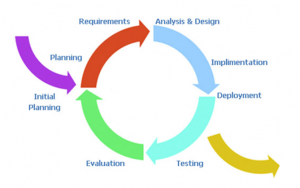
– Iterative-incremental development is the process of establishing requirements, designing, building and testing a system in a series of short development cycles.
Examples are: prototyping, Rapid Application Development (RAD), Rational Unified Process (RUP) and agile development models.
– A system that is produced using these models may be tested at several test levels during each iteration
– Regression testing is increasingly important on all iterations after the first one.
– Verification and validation can be carried out on each increment.
Agile – Scrum development
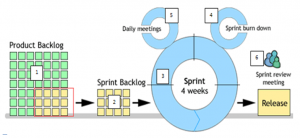

Term: VV&T – Verification, Validation and Test
Verification ( Do it right)
- Question: Are we building the product right?
Validation – ( Do right it)
- Question: Are we build the right product?
Testing
- The process of exercising software to verify that it satisfies specified requirements and to detect faults
Testing within a Life Cycle Model
There are several characteristics of good testing:
- For every development activity there is a corresponding testing activity
- Each test level has test objectives specific to that level
- The analysis and design of tests for a given test level should begin during the corresponding development activity
- Testers should be involved in reviewing documents as soon as drafts are available in the development life cycle
2.2.1 Component Testing (K2)
Test basis: Component requirements, detailed design, Code
Typical test objects: Components, Programs, Data conversion / migration programs, Database modules
- Component testing (also known as unit, module or program testing)
- Searches for defects in, and verifies the functioning of, software modules, programs, objects, classes, etc., that are separately testable
- Done in isolation from the rest of the system
- Stubs, drivers and simulators may be used.
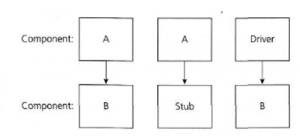
- Include testing of functionality and specific non-functional characteristics : Robustness testing, security
- Test cases are derived from work products such as a specification of the component, the software design or the data model.
- Component testing occurs with access to the code being tested and with the support of a development environment, such as a unit test framework or debugging tool.
- Defects are typically fixed as soon as they are found, without formally managing these defects.
- One approach to component testing is to prepare and automate test cases before coding. This is called a test-first approach or test-driven development.
2.2.2 Integration Testing (K2)
Test basis: Software and system design, Architecture, Workflows, Use cases
Typical test objects: Subsystems, Database implementation, Infrastructure, Interfaces, System configuration and configuration data
- Integration testing tests interfaces between components, interactions with different parts of a system, such as the operating system, file system and hardware, and interfaces between systems.
- There may be more than one level of integration testing and it may be carried out on test objects of varying size as follows
- Component integration testing tests the interactions between software components and is done after component testing
- System integration testing tests the interactions between different systems or between hardware and software and may be done after system testing.
Test approach:
Big-bang integration
Incremental integration
- Top-Down integration
- Bottom-up integration
2.2.3 System Testing (K2)
Test basis: System and software requirement specification, Use cases, Functional specification, Risk analysis reports.
Typical test objects: System, user and operation manuals, System configuration and configuration data
- System testing is concerned with the behavior of a whole system/product.
- The test environment should correspond to the final target or production environment as much as possible in order to minimize the risk of environment-specific failures not being found in testing.
- Include tests based on risks and/or on requirements specifications, business processes, use cases, or other high level text descriptions or models of system behavior, interactions with the operating system, and system resources.
- Investigate functional and non-functional requirements of the system, and data quality characteristics.
- Testers also need to deal with incomplete or undocumented requirements.
- System testing of functional requirements starts by using the most appropriate specification-based (black-box) techniques for the aspect of the system to be tested.
- An independent test team often carries out system testing.
2.2.4 Acceptance Testing (K2)
Test basis: User requirements, System requirements, Use cases, Business processes, Risk analysis reports
Typical test objects: Business processes on fully integrated system, Operational and maintenance processes, User procedures, Forms, Reports, Configuration data
- Acceptance testing is often the responsibility of the customers or users of a system; other stakeholders may be involved as well.
- The goal is to establish confidence in the system, parts of the system or specific non-functional characteristics of the system.
- Finding defects is not the main focus in acceptance testing.
- Acceptance testing may assess the system’s readiness for deployment and use
- Acceptance testing may occur at various times in the life cycle
Typical forms of acceptance testing include the following
- User acceptance testing
Typically verifies the fitness for use of the system by business users
- Operational (acceptance) testing
The acceptance of the system by the system administrators, including:
Testing of backup/restore or disaster recovery
- User management
- Maintenance tasks
- Data load and migration tasks
- Periodic checks of security vulnerabilities
3.Contract and regulation acceptance testing
- Contract acceptance testing is performed against a contract’s acceptance criteria for producing custom-developed software.
- Regulation acceptance testing is performed against any regulations that must be adhered to, such as government, legal or safety regulations.
4.Alpha and beta (or field) testing- Test Alpha và beta
- Alpha testing is performed at the developing organization’s site but not by the developing team.
- Beta testing, or field-testing, is performed by customers or potential customers at their own locations.
2.3 Test Types (K2)
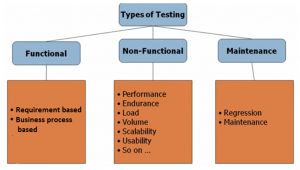
Xem nội dung tóm tắt chương 3
Xem nội dung tóm tắt chương 4
Xem nội dung tóm tắt chương 5
Xem nội dung tóm tắt chương 6
Ngoài ra bạn có thể download nhiều tài liệu hay khác về testing theo link sau: http://bit.ly/2r3szBD
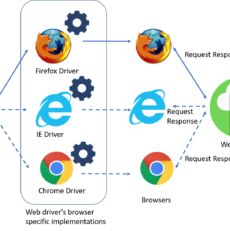







Leave a comment